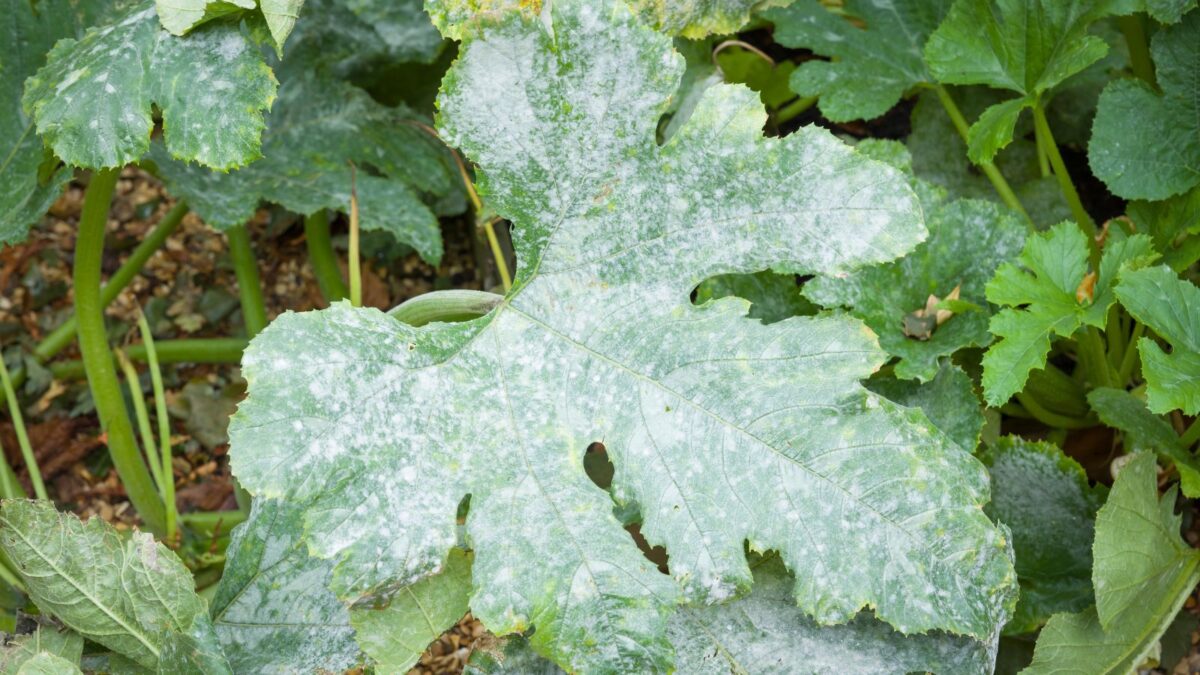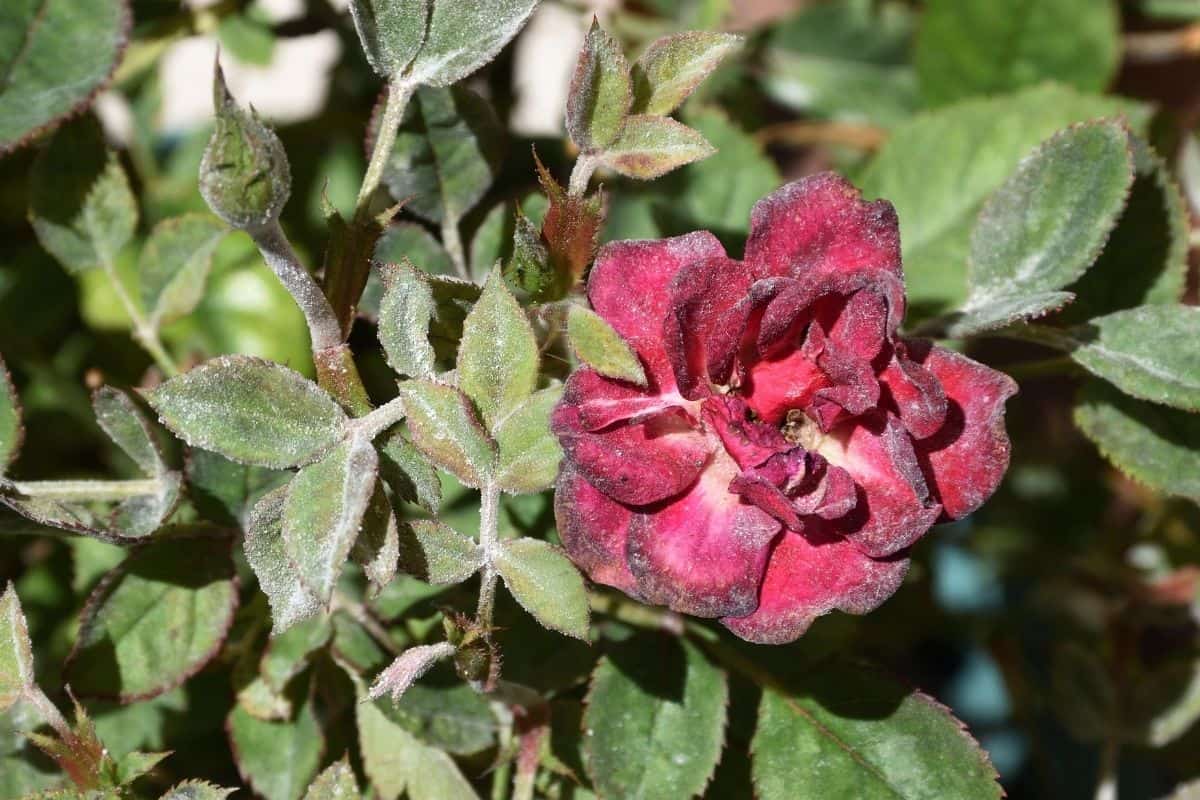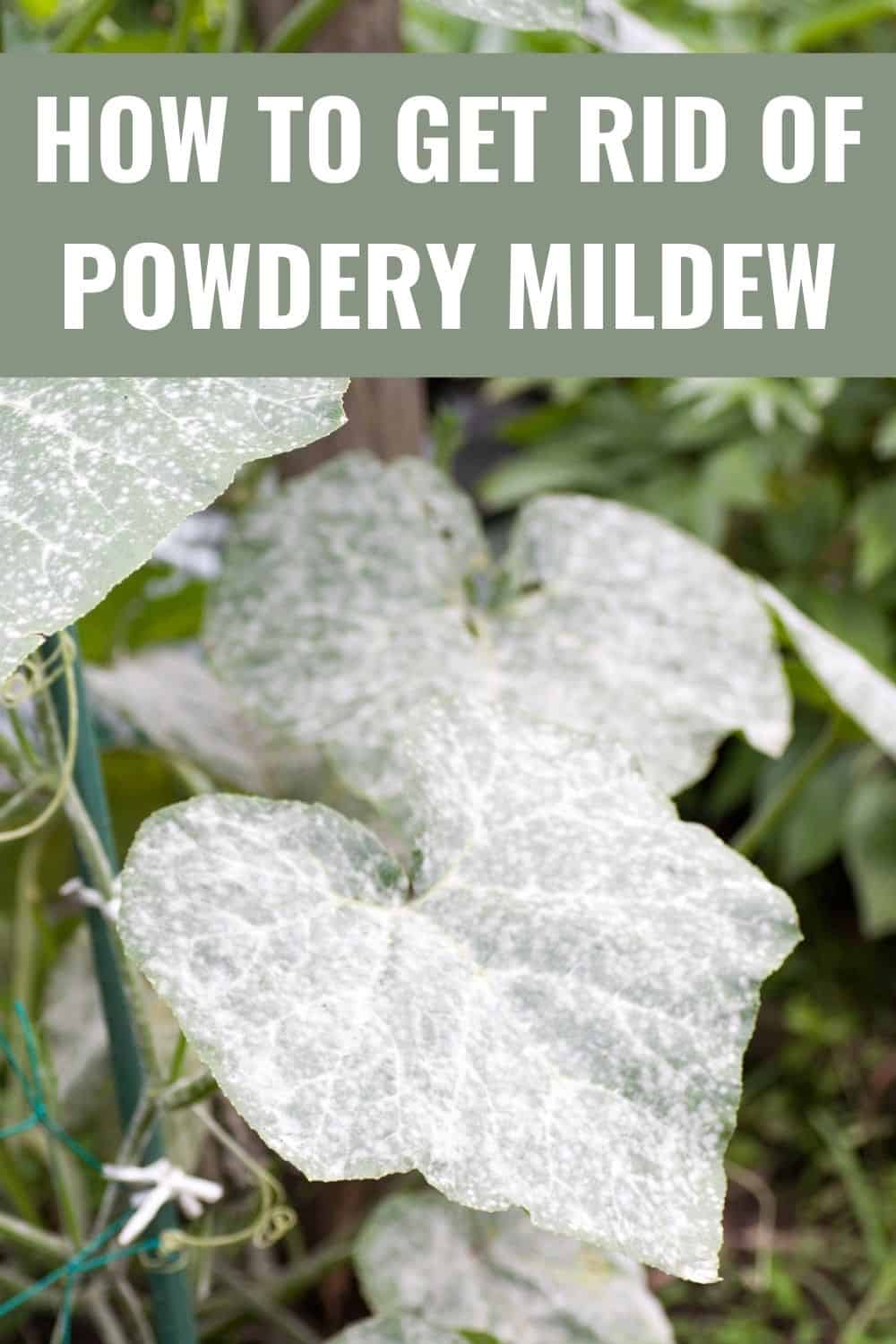“Help, my plant is covered in a white, powdery fungus! What do I do?” First, don’t panic. While powdery mildew may not look pretty, it rarely causes significant damage except in cases of severe infection. In fact, you may not need to do anything at all. Read on to learn whether your situation is a cause for concern, and if so, how to get rid of powdery mildew and prevent it from returning.

How to Get Rid of Powdery Mildew
Before learning how to get rid of powdery mildew, we need to know what to look for.
Symptoms of powdery mildew

Plants affected by powdery mildew often appear to be covered in white powder or cobwebs. Upon closer inspection, you may notice that the mildew forms white or gray spots or blotches on leaves, buds, and stems, and toward the end of the growing season, you might see tiny orange or black balls within the pale fungal mats.
Abnormal growth or discoloration sometimes occurs alongside or in place of the powdery patches. Leaves may become dwarfed, curled, or twisted, especially younger growth, and they may turn yellow, red, or purple around the infected site or even entirely.
Severe cases can reduce the production of fruits and vegetables as well as cause scarring on their skin, though the latter is only cosmetic damage. Ornamental plants also become unsightly, looking sickly or discolored. Affected flowers develop abnormally or even fail to open entirely.
Powdery mildew affects more than 10,000 types of plants, including ornamental grasses, annual and perennial flowering plants, shrubs, and trees. Some common hosts include azalea, blueberry, crabapple, cucumber, dahlia, dogwood, lilac, oak, pecan, peony, phlox, rhododendron, rose, snapdragon, squash, and zinnia.
Although it affects such a wide range of plants, powdery mildew is species-specific and therefore will not spread from one type of plant to another.
Causes of powdery mildew
A fungal disease, powdery mildew is caused by fungi in the Erysiphaceae family. The fungi begin producing spores in the spring as temperatures warm, with spores spreading on the wind to neighboring plants and as far as hundreds of miles away.
While low humidity encourages spore dispersal, high humidity is often required for germination, making cool, dry days and humid nights with temperatures of 60-80 F favorable for powdery mildew.
When spores land on a host plant, they quickly germinate, starting a new infection. The infection starts as small, powdery white spots that spread to form a mat on the plant’s surfaces.
Powdery mildew absorbs nutrients by penetrating the tissue of the host plant, and long chains that form outward from the plant surface produce spores that then spread to other plants.
How to Treat Powdery Mildew
1. Tolerate mild cases
Mild cases of powdery mildew, especially on ornamental plants, may not need any treatment at all. By “mild case,” I mean that the fungus only appears on a few plants and does cause any harm; i.e., the plant displays normal growth and flowering.
Rather than immediately treat this mild infection, you may choose to simply monitor it and perhaps employ some of the preventative measures listed in the next section to keep it from spreading or worsening.
2. Remove affected parts
To prevent powdery mildew from spreading, remove all affected parts of the plant. If only a few leaves are affected, simply handpick them; otherwise, use pruners to cut out stems that show signs of infection. Make sure to pick up any fallen foliage as well, because if it contains powdery mildew, it can infect the living plant.
All infected debris should be disposed of, such as by burning in a brush pile or fire pit, as a home compost pile might not get hot enough to destroy the fungus.
How to Prevent Powdery Mildew
Perhaps the best way to get rid of powdery mildew is by enacting preventative measures rather than treating the fungus directly. In other words, make your garden less hospitable to powdery mildew, and it will be less likely to stick around.
1. Reduce humidity and improve airflow
Because powdery mildew thrives in humidity, reducing moisture and improving airflow can prevent infection. This starts with planting: always space plants far enough apart to allow for adequate airflow between them. Regular pruning also improves air circulation within each plant, and mulching will help keep moisture in the soil (and not on the plant). Avoid overhead irrigation, and instead, aim water at the base of each plant to keep the leaves from getting wet.
2. Avoid over fertilizing
Nitrogen encourages new growth, which is more susceptible to powdery mildew infection. Therefore, avoid using lots of nitrogen fertilizer, especially later in the season. Instead, before applying fertilizer, test your soil and apply only what is needed based on the test results and what each type of plant requires for optimum health.
3. Choose resistant plant varieties
If you experience significant problems with powdery mildew in the garden, consider replacing the most susceptible plants with resistant varieties and, when choosing plants in the future, looking for powdery mildew resistance among the desirable traits. You can find resistant varieties of ornamentals like crepe myrtle, dogwood, phlox, rose, and zinnia as well as vegetable plants.
4. Use natural fungicide
There are two important things to know before considering fungicide as a powdery mildew control option.
- First, to be effective, fungicide must be applied as a preventative measure before infection begins or as soon as symptoms begin to develop; it will not cure an existing infection.
- Second, fungicides should not be used as your first line of defense but rather to protect only high-value plants that are difficult to replace and that have had severe infections in the past.
Look for natural options such as neem oil, horticultural oils, or even a DIY baking soda spray (1 teaspoon baking powder in 1-quart water) to avoid introducing toxins to your garden and the surrounding environment.
While the scary-looking powdery substance coating your plants may have you scrambling for treatment options, the situation may not be as dire as it first appears.
Powdery mildew often causes little harm, and many preventative measures, such as those listed above, can be employed to keep it from spreading or worsening.
Learn more about garden pests and diseases.




8 Best Companion Plants For Bee Balm (And 4 To Avoid)
Thursday 8th of June 2023
[…] should probably not be planted too close to it. This is because delphinium is a common host for powdery mildew, which could spread to any bee balm planted […]
How To Plant A Jane Magnolia Tree For Stunning Spring Blooms
Tuesday 6th of December 2022
[…] of slow-release fertilizer once a year, in the fall. This will help with pests and diseases such as powdery mildew as the magnolia grows. however, don’t fertilize a newly planted tree: wait until the […]
Garden Pests And Diseases - How To Save Your Vegetables, Herbs, And Flowers
Wednesday 17th of August 2022
[…] powdery mildew […]
Growing Climbing Honeysuckle Vines In Your Garden
Wednesday 19th of January 2022
[…] Powdery mildew is another problem you might see on your honeysuckle plants. This is essentially mold, and it suggests there is not good air circulation around the plant. The most common reason for this is overcrowding, so it can be easily avoided. Also, if you begin to see overcrowding happening, you can take control and maintain it before it leads to diseases such as mold and mildew. […]